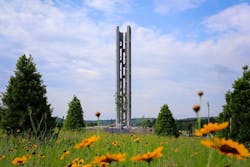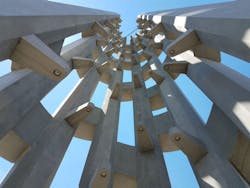Precast concrete tower honors victims of United Airlines Flight 93
The Tower of Voices, part of the last major phase of work at the Flight 93 National Memorial located in Somerset County, Penn., where United Flight 93 crashed on Sept. 11, 2001, is conceived as both a musical instrument and a tower.
The 93-foot-tall precast tower comprises 40 custom-made aluminum wind chimes, with each chime producing a distinct musical note. Together, these chimes create a set of “40 voices” to memorialize the 40 passengers and crew who lost their lives when the flight was hijacked by terrorists. The chimes are suspended at variable heights, starting 20 feet above the main plaza and ascending to the top. The customizable features included in the precast concrete will enable the chimes to “sing” even at low wind speeds.
The tower form is designed as an enclosure that cradles the 40 chimes and opens towards the public plaza on which it stands. The precast concrete columns with branch connectors abstractly recall the Hemlock grove near the crash site. Precast concrete was used for the tower to accommodate the complex and unusual shapes of each component and because it had the strength needed to support the tall, slender frame.
The design process included a combination of consultants including a musician, chimes artist, acoustical engineer, and wind consultants. Diagonal column splices allowed the joints to blend in with diagonal beams. At the joints, pockets and splines aligned the column pairs vertically, creating symmetry in a structure with various angles, curves, and heights.
The project acts as a landmark memorial feature near the entrance of the park.

